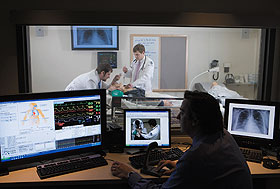  |
| HOME | THIS ISSUE | CALENDAR | GRANTS | BACK ISSUES | < BACK | NEXT > |
Medical students learn from SimMan, a patient simulatorby Carolyn Pennington - April 20, 2009 |
||||
| When you first walk through the door, you may think you’ve entered a typical hospital procedure room – complete with cardiac monitor, fully-stocked crash cart, and a large flat screen monitor where digital images of a patient’s internal organs can be easily viewed. Not until you look closely at the patient on the examining table do you realize that all is not as it seems. The patient, dressed in khakis and a blue denim shirt, is a high fidelity patient simulator known as SimMan that allows UConn medical students to prod, poke, and pull with barely a peep. But that doesn’t mean SimMan can’t communicate with the students. He comes with prerecorded sounds and utterings, he can cough, moan, and wheeze. SimMan can also talk – his voice is courtesy of Dr. Thomas Nowicki, emergency room physician and director of medical simulation at UConn. Nowicki operates from behind a one-way window in a control room next door. He can make SimMan sound cheerful, anxious, cranky, or downright mad – depending on the malady the mannequin is suffering and the particular medical scenario. A computer makes SimMan tick – or not tick, as when Nowicki programs him to go into cardiac arrest. Students can use a real defibrillator to shock his artificial heart back into rhythm. If he’s choking, they can cut through his plastic skin (he comes with extra) to perform a tracheotomy and get him breathing again. Compressed forced air makes his chest expand and contract. If he has a collapsed lung, you’ll hear air escape when a needle is inserted into his chest. He can clench his jaw, his tongue can swell, and his mouth can froth. Students can listen to his bowel sounds, or check his pulse in his wrist or feet. His vital signs are broadcast on the clinical monitors in the room, keeping track of his blood pressure and pulse rate. Another monitor can display X-rays and EKG results. There are cameras in the room that can zoom in and follow the action of the medical student. From behind his window, Nowicki can hear what is going on, and he can talk into the room in order to guide the student, or act as if he is the patient and respond to the student’s questions. “SimMan allows students to take the knowledge they already have and put it to use,” says Nowicki. “The real learning happens during the debriefing session,” he adds. That’s when Nowicki and the other students who are watching in the adjacent room, discuss in detail what happened during the SimMan scenario.
Nowicki can also videotape the session and play it back so the student can see first hand what he or she said or did wrong. Another obvious benefit is patient safety. “Human patients can fake only so many different illnesses,” says Benjamin Silverberg, a fourth-year medical student who will be doing his residency in family medicine. “For example, a collapsed lung –not too many people are going to allow you to intubate them just for practice. SimMan allows us to really hone our skills before we have to treat a living, breathing person.” And sometimes, it’s a good thing when a bad thing happens to SimMan. “During an exam, if I do something wrong with a human patient, a supervising doctor is going to jump in and take over,” says Austin Schirmer, a second-year medical student. “If I’m treating SimMan and something goes wrong, I have to keep going, deal with the consequences, and learn from my mistakes.” Nowicki says it forces students to make big decisions and start to think in a realistic fashion. “It’s a different way of learning,” he says. “The students’ weaknesses and the gaps in their knowledge are exposed. We then try to fill in those gaps. We can unmask what they might have missed in class.” The simulation class is offered in the students’ fourth year, during their emergency medicine rotation. UConn also has a SIM baby. The baby’s lips can turn blue and he can have seizures. The mannequins cost between $40,000 and $150,000 and are manufactured by the Norwegian company Laerdal. |
| ADVANCE HOME UCONN HOME |

